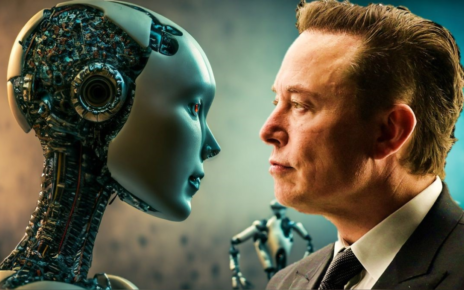Table of Contents
We have put together a short guide on how to travel in time, what theories and experiments exist and who is working on creating a time machine today
What is a time machine
A time machine is a device that, in theory, could be used to travel through time.
However, scientists do not understand it as a physical machine or mechanism, as in the movies, but as a curved space-time [1] : for example, in the form of a “wormhole” or “doughnut”. Inside it, you can move from one point in space-time to another, due to focused gravitational fields. But such fields must be super powerful, and they must be controlled with maximum precision.
A wormhole is one of the options for a “time machine”
There are also versions that the time machine is exotic matter with negative density. If you push it, it will move in the opposite direction to normal. However, nothing similar has yet been discovered.
Is it possible to travel in time?
In science fiction films like Star Trek or Back to the Future, heroes simply get into a car or other vehicle and find themselves in the past or future. In reality, everything is much more complicated, and there is no consensus on this matter yet.
Albert Einstein was the first to describe time as the “fourth dimension” . He believed that it moves only forward, but, at the same time, relatively: that is, it can flow at different speeds in different conditions. If you move at the speed of light (that is, 299,792 km/sec), then it will slow down for you – compared to those who are standing still. But, according to the physicist’s calculations, your mass should be infinite, and your length should be zero.
Einstein also argued that gravity can change time: supermassive objects, like black holes, seem to bend time around them. This was also proven – with the help of GPS satellites and ultra-precise watches. Traveling through black holes is perhaps the most popular method described in the movie Interstellar. Near a hole or its model, beyond the event horizon, time moves twice as slow, or even stops altogether.
Stephen Hawking , who wrote the book A Brief History of Time, supported Einstein’s theories regarding black holes, as well as the “wormholes” or “wormholes” that permeate the entire Universe. However, he did not believe that it was possible to travel into the past.
“Time Travelers Party” by Stephen Hawking
To prove it, he conducted an experiment: he organized a party in 2009 and sent out invitations after it ended. But none of those invited in the future came to it. However, Hawking did not rule out that a time machine would be built after his death .
Based on Einstein’s theories, NASA proposed that it was possible to travel through “wormholes” or “wormholes” in space-time [5] . These are something like tunnels, after passing through which we will find ourselves in another dimension. But such “wormholes” collapse almost instantly, and only ultra-small particles can pass through them.
Another hypothesis is the “infinite Tipler cylinder” . Astronomer Frank Tipler proposed a mechanism that contained matter the size of ten solar masses, rolled into an infinitely long and very dense cylinder. If it rotates at a billion revolutions per minute, the spacecraft will spiral into the cylinder and end up in a “closed time-like curve”—a world line where everything returns to its original space-time point.
String theory within the framework of quantum mechanics assumes the presence of 11 dimensions [6] . In one of them there may be a portal for time travel.
Cosmic strings are the thinnest clots of energy passing through the entire length of the Universe and possessing enormous mass. Their diameter is thinner than an atomic nucleus, but they are very dense: 1 thousand km of such a string weighs as much as the Earth. Therefore, they, like black holes, can also bend space and time around them. There is a theory that such strings are infinite and form closed loops – “folds” of space-time. You can also travel through time inside them.
What are the main problems in creating a time machine?
For the foreseeable future, no human-made object can approach the speed of light.
A person will not be able to be near objects with gigantic gravity, like black holes: he will die immediately.
Hypothetical conditions for time travel – such as infinite or ultra-low mass, zero length and others – are also unattainable.
The deformation of space-time can cause a powerful flow of radiation that will destroy all life.
There are some theories – for example, by physicist Richard Muller [7] – that it is impossible to go back, since the Universe is constantly expanding, both in space and in time. In other words, in the past there was, as it were, less time, but in the future, on the contrary, there is more of it. And we cannot, in our current state, find ourselves at the desired point in the past or future – in both cases these will be completely different worlds with which we have no connection. To make such travel possible, we first need to reduce or increase the volume of space-time.
And yet, people have been trying for centuries to create time machines, or at least to recreate the conditions under which such travel is possible.
What happens if you change the past?
This question most often arises in books and films – like “The Terminator”, “The Butterfly Effect” or “Back to the Future”. Scientists call it the “murdered grandfather paradox” [8] : when a time traveler goes back in time, kills his grandfather in his youth, and as a result disappears – because he was never born.
Opponents of the theory argue that this is impossible: you can go back in time only along a closed curve, within which all events are looped with each other. As a visual confirmation, they cite a billiard ball, which moves through a wormhole along a given trajectory and cannot in any way interfere with itself.
British mathematician and philosopher Gerald James Withrow believed that if traveling into the past were possible, we would remember it before we set off.
Who has already tried to invent a time machine?
Back at the end of the 19th century, science fiction writers – among them Enrique Gaspar and Rimbau, as well as Herbert Wells – described the first prototypes of time machines. However, scientific justifications appeared at the beginning of the 20th, with the advent of Einstein’s theories.
In 1948, Austrian mathematician and philosopher Kurt Gödel found a solution to Einstein’s equations concerning gravity and the rotating universe. In it, light also rotates along with other objects, which is why the latter move along closed trajectories in both space and time.
Gödel also wrote that at every point in space there is a light cone of the past and a cone of the future. Inside each of them is a world line – a continuous curve in space-time that consists of events. On each world line, time flows differently.
Cones of the past and future by Kurt Gödel
If you tilt the cones at a certain angle, you get a circle inside – this is a time machine. You just need to create a gravitational field, or curvature, in which the cones tilt at the desired angle. Gödel assumed that such a Universe already exists somewhere, but so far we know nothing about it.
In 1943, an experiment was conducted at the US Navy base in Philadelphia. As part of it, a special electromagnetic screen was created around the destroyer Eldridge, which reflected radar signals. Some witnesses claimed that after this the ship allegedly disappeared, and then appeared hundreds of kilometers away in Virginia. But years later, the sailors who participated in the experiment refuted this.
In 1988, American physicist and astronomer Kip Thorne calculated under what conditions Gödel’s time machine would work and how possible it would be. To do this, you need to start the time machine, accelerate one end of the “wormhole” to near light speed, slow down, then accelerate in the opposite direction, slow down again, dive into the hole, jump out at the other end and then outside, as quickly as possible, rush to the other end. This will create a time loop between the past and the future.
Thorne’s time machine
Subsequently, the model was complicated, considering it in four and five dimensions, where new layers and conditions were added. As a result, the final “working” version does not yet exist, but many in their calculations still rely on Gödel’s hypothesis.
In 2017, scientists from the USA and Canada created their own mathematical model of a time machine – TARDIS (Traversable Acausal Retrograde Domain in Spacetime). It looks like a “bubble” or “box” that moves in a circle, passing through space-time along “wormholes”.
For them to arise, space-time must be curvatured in a certain way. At the same time, the appearance of the black holes that Hawking spoke about is not necessary. The TARDIS will move in a closed curve so that the people inside experience constant acceleration. Those who observe this from the outside will see two versions of the event: one in which time moves normally, and the other in the opposite direction.
Earlier this year, astrophysicist Ron Mallett said it was possible to turn back time. He also relied on Einstein’s theories and equations and proposed using a ring laser with continuously circulating beams, which could gain the required speed and create a portal to the past. These are the same “wormholes” that we wrote about above. The professor has already developed a prototype of such a device and is testing it. However, his future time machine has a serious limitation: it can only go back no further than the moment it was turned on.
Conclusions about time machines
Opinions and experiments in modern science can be reduced to three directions:
Time travel is impossible because it creates insurmountable paradoxes or is simply technical.
Travel is possible, but not in the way we imagine it: you cannot go to a specific point in the past or in the future.
Travel is possible, you just need to find a suitable Universe and curved space-time in it.

More: https://en.wikipedia.org/wiki/Time_dilation


